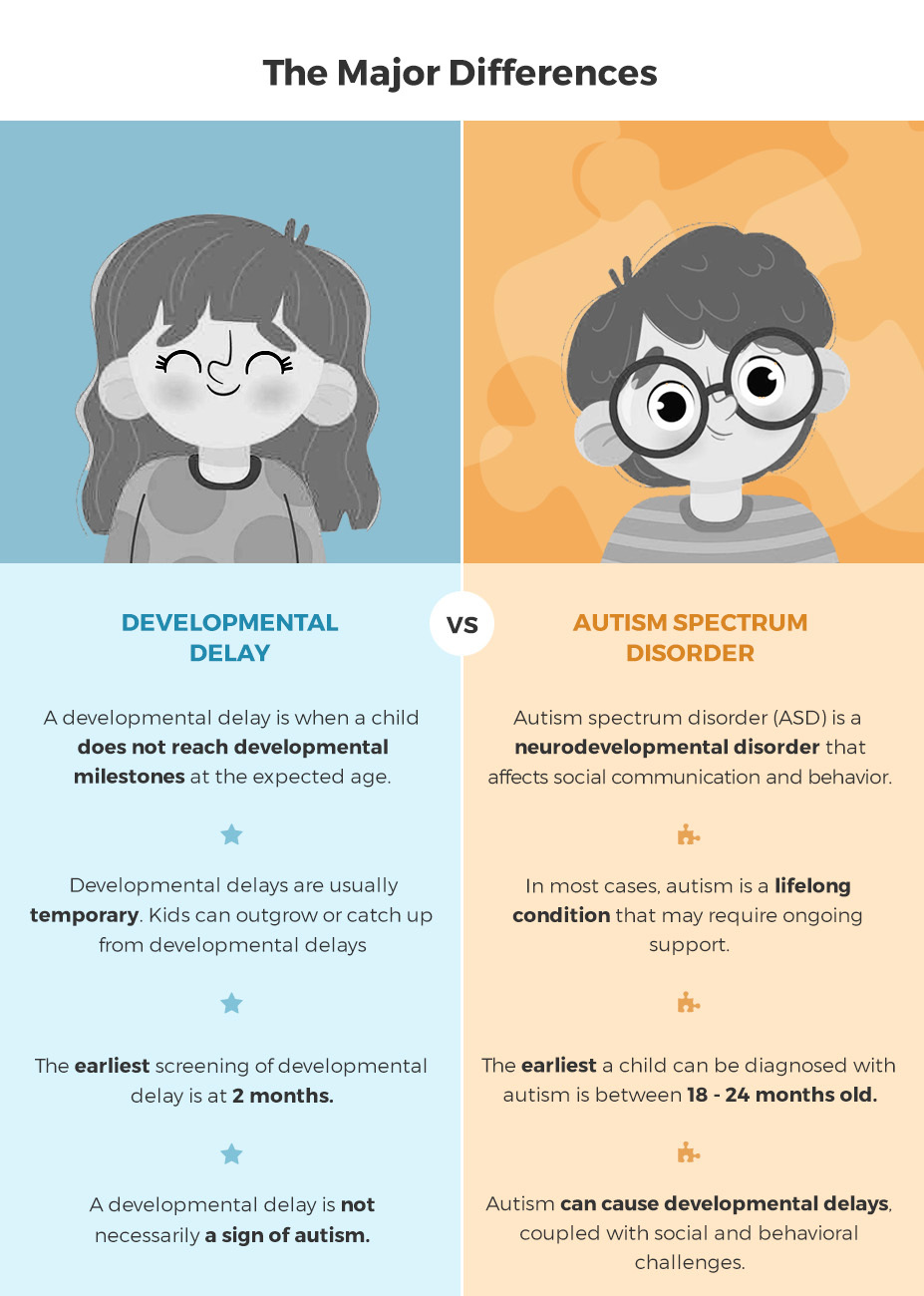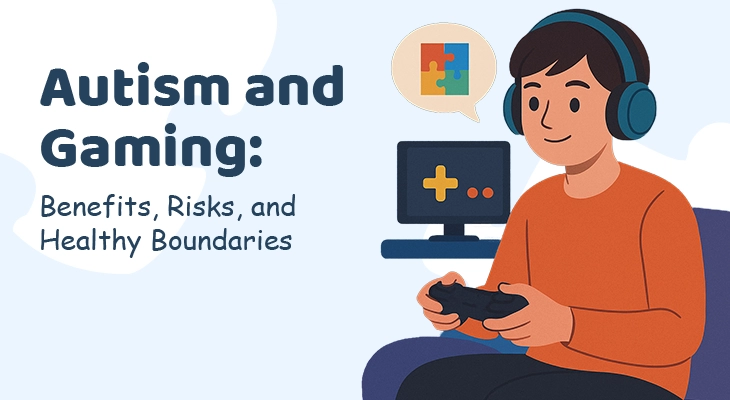Sarah was a first-time mom, and she was over the moon when her son, Michael, was born. He was a healthy baby, and Sarah loved spending time with him. But as Michael got older, Sarah started to worry. He wasn’t meeting the same developmental milestones as other babies his age. He didn’t make constant eye contact as much as other babies, and he didn’t seem to be interested in playing with other children.
Sarah started to research autism spectrum disorder (ASD) online, and she began to think that Michael might have ASD. She was scared and didn’t know what to do. She talked to her pediatrician, who referred her to a specialist for further evaluation.
The specialist evaluated Michael and diagnosed him with development delay. Although still concerned about Michael’s development delay, the diagnosis sparked her curiosity about the differences between autism and developmental delay.
Sarah’s story is a reminder that developmental delays can be scary for parents and can be misunderstood as signs of autism. While developmental delay and autism overlap in some areas, both are distinct conditions. This blog explains the key differences between developmental delay vs autism spectrum disorder (ASD), and is a must-read for all first-time parents.
Table of Contents
- What are developmental milestones?
- Why are developmental milestones important?
- How is Autism spectrum disorder different from development delays?
- Development delay vs Autism Spectrum Disorder – The Major Differences
- Development delay vs Developmental Delay vs Autism Spectrum Disorder – The Key Differences and Similarities
- Are Developmental Delays a Sure Way of Detecting Autism?
- Be it Developmental Delay or Autism, Early Intervention is Important
- Conclusion
- References
What are development milestones?
As per the Centers for Disease Control and Prevention (CDC), development milestones are the skills and abilities that most children develop at a certain age. They include simple tasks like making lots of sounds such as “mamamama”, taking a first step, smiling for the first time, banging two things together, waving “bye-bye” and so on.
Children progress through development milestones in all areas of their development, including play, learning, language, behavior, and motor skills. The CDC’s developmental milestones list specific levels of achievement for each age, starting with 1 month and moving through adolescence, categorized into 4 domains:
- Social / Emotional Milestones
- Language / Communication Milestones
- Cognitive Milestones (learning, thinking, problem-solving)
- Movement / Physical Development Milestones
Here is an example of a developmental milestone in each category for a 9-month-old baby:
Video credit: CDC, Important Milestones: Your Baby By Nine Months
Social / Emotional Milestone
Shows stranger anxiety i.e the baby is shy, clingy, or fearful around strangers
This milestone shows that the baby is developing their social-emotional skills and is starting to understand the difference between familiar and unfamiliar people.
Video credit: CDC, Important Milestones: Your Baby By Nine Months
Language / Communication Milestone
Waves “bye-bye”
This milestone shows that the baby is developing their language skills and starting to communicate.
Video credit: CDC, Important Milestones: Your Baby By Nine Months
Cognitive Milestone
Bangs two things together
This milestone shows that the baby is developing their fine motor skills and hand-eye coordination.
Video credit: CDC, Important Milestones: Your Baby By Nine Months
Physical Milestone
Gets to a sitting position by herself
This milestone shows that the baby is developing their gross motor skills and mobility.
Why are development milestones important?
Children develop at their own pace, but most reach developmental milestones at similar ages. These milestones are important indicators of a child’s healthy growth and development.
- Meeting developmental milestones on time is a sign that a child is progressing normally. This is also called neurotypical development.
- Early achievement of developmental milestones may suggest that a child is ahead of their peers in terms of development.
- But not reaching milestones on time, or reaching them much later than other children, is a developmental delay – a warning sign or red flag.
According to NIH, developmental delays occur in 10-15% of pre-school children [1]. Children who experience developmental delays are eligible for early intervention services, which are programs designed to help them catch up and reach their full potential.
Speech delay is an example of developmental delay that can affect a child’s ability to communicate effectively.
A speech delay is a condition in which a child does not develop speech skills at the same pace as their peers.
It means that the child is learning to form speech sounds or develop language skills at a slower rate than average.
Developmental delays can be in one specific area (ex. Speech Delay). When your child has this type of developmental delay, it doesn’t mean they are autistic. They might just be what’s known as a “late talker.” Minor development delays, especially when present in one area, are no cause for concern and are usually temporary.
But, if your child has significant ongoing delays or delays in more than two areas, it could indicate a learning disability. Scientifically, a delay in more than two areas is known as Global Developmental Delay (GDD).
How is Autism spectrum disorder different from developmental delays?
Developmental delay and autism spectrum disorder are two different conditions, but they can sometimes present with similar symptoms. A child diagnosed with a disorder on the autism spectrum usually experiences developmental delays. But while developmental delay is usually a temporary issue, Autism Spectrum Disorder (ASD) is a developmental disability caused by differences in the brain [2]. Autism or autism spectrum disorder (ASD) is a lifelong condition with core behavioral symptoms appearing during infancy or early childhood [3] .

Developmental delay is a general term for when a child’s development falls behind in one or more areas. Autism spectrum disorder is a neurodevelopmental disorder that affects social communication and behavior.
#developmentaldelays #autismspectrumdisorder
Developmental Delay vs Autism Spectrum Disorder - The Major Differences
To help you understand the differences between developmental delay vs autism spectrum disorder (or global developmental delay vs autism spectrum disorder), we have compiled the following table:

Download Download & share this infograph in your network [Free Download]
Developmental Delay vs Autism Spectrum Disorder - The Key Differences and Similarities
This infographic compares and contrasts developmental milestones and autism spectrum disorder, highlighting the key differences between the two conditions. It is important for first-time parents to understand the differences between the two so they can provide the best possible support for their child.
| Developmental Delay | Overlap | Autism |
|
|
|
|
|
|
|
|
|
|
|
Are Developmental Delays a Sure Way of Detecting Autism?
They are not. In some cases, autistic children may have developmental delays that are not immediately apparent. It has been observed that in many cases, missed milestones can be masked, more subtle or even invisible. This is because autistic children are neurodivergent. This means they aren’t simply delayed; rather they learn and behave differently from their typical peers.
Although every child is unique and displays different symptoms, watch out for these common signs that may indicate your child is autistic.

Remember, developmental delays are not a sure way of detecting autism. Due to their neurodivergent behavior, missed developmental milestones can often be masked in autistic children.
#developmentaldelays
If you are concerned about your child’s development, it is important to talk to your doctor. Diagnosing autism can be difficult and complex, as it may not be apparent from a single test. That is why we have created a comprehensive guide on Diagnosing Autism – A List of Essential Tests and Key Indicators You Can’t Afford to Ignore. The guide gives a comprehensive list and understanding of all tests for autism including developmental screening tests for autism, diagnostic tests for autism, medical tests for autism and other supplemental tests for autism.
Be it Developmental Delay or Autism, Early Intervention is Important
When a child is diagnosed with autism or other developmental conditions, the best thing to do to aid with their development is to start early intervention as soon as possible. Below is a link of state-wise programs for State Early Intervention Information:
This website provides information about early intervention programs in each state, including eligibility requirements, how to access services, and contact information.
Early intervention specialists can screen for and diagnose autism and other developmental conditions in children from a very young age. The benefits of early intervention in autism (ASD) are life changing. According to a study by National Institute of Child Health and Human Development (NICHD), early intervention for certain children with autism enables remarkable advancement to the extent that the kids no longer fall within the autism spectrum as they grow older.
So, the sooner your child is diagnosed and begins early intervention treatment, the better their chances are of developing important life skills at a young age.
Conclusion
Although some signs and symptoms of developmental delays vs autism spectrum disorder in toddlers may look the same, they are two different conditions. While children with autism usually experience developmental delays in one or more areas, not every child who experiences a delay in their development has autism. In some cases of autistic children, the developmental delays could be masked, subtle or even invisible.
Hence, it is important for parents to understand the differences and know when delays in their children’s development are normal and when they could be a sign of autism or other developmental disorders.
If you are concerned that your child may have developmental delay or autism spectrum disorder, it is important to talk to your pediatrician. They can assess your child’s development and refer you to a specialist for further evaluation if necessary.
References
- NIH, Developmental delay: identification and management at primary care level
- CDC, Autism Spectrum Disorder
- NIH, Is Autism Inborn and Lifelong for Everyone?
- CDC, Important Milestones: Your Baby By Nine Months
- CDC, Autism Signs
- NIH, Prevalence and Developmental Profiles of Autism Spectrum Disorders in Children With Global Developmental Delay




